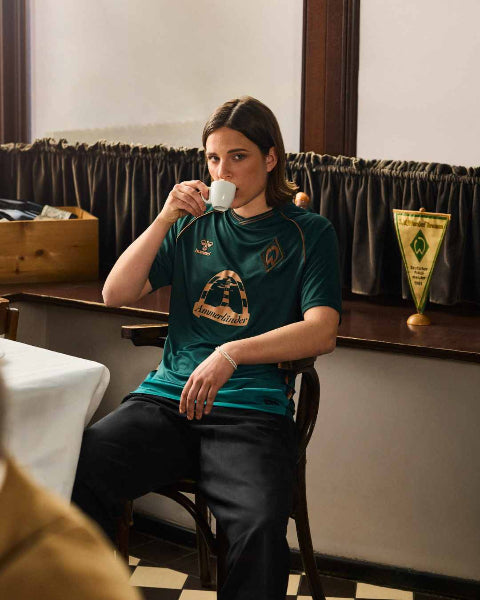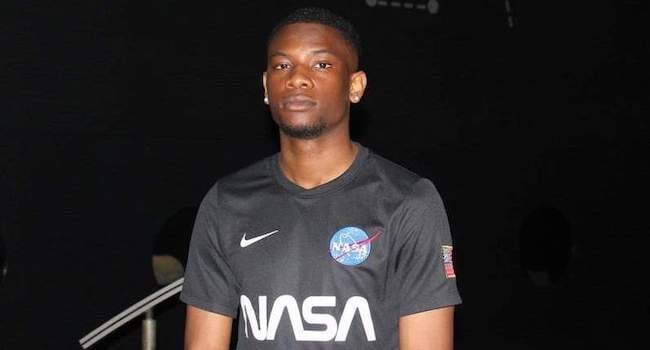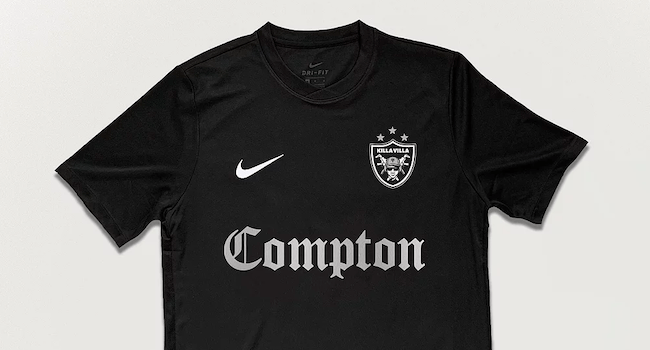Recently added
Vintage shirts
Concept kits
Legends
Ted Philipakos: The story behind Venezia in 2020
by Matt Leslie February 05, 2022 8 min read

If you've been paying even the slightest bit of attention to FSC’s social channels over the last couple of months, then you’ll know that while we love all shirts, one set of shirts in particular has caught our eye in 2020.
Is there a better home and away combo this season? ⚫🟢🟠 pic.twitter.com/sswtDI5YUq
— Football Shirt Collective (@thefootballsc) September 14, 2020
We’re of course talking about the famous Arancioneroverdi of Venezia FC. The standout colour scheme of the home shirt and the beautifully Italian look of the away jersey hooked us from the start, and judging by how quickly all of you snapped up the first run we had in our store, the shirts had a similar effect on the rest of the football shirt community.
We wanted to get the full low-down on two of 2020s best football shirts, and to do that FSC spoke to Ted Philipakos and Diego Moscosoni of creative agency Fly Nowhere. We chatted about their own background in football and design, their collaboration with Venezia FC and how they view football shirt culture moving forward.
Ted, Diego and Fly Nowhere
Q: So, Ted and Diego, could you start off by telling us a bit about your background in the football world?
Ted: I’m originally from New York. Before we created Fly Nowhere, I started my career in football as a player agent, working both in Europe and the States, later became a professor in sports marketing and sports in society at New York University, and eventually moved to Europe as a club executive, serving as CEO at Italian clubs Venezia FC and AC Reggiana.
Diego: My family is also from New York, but as a kid I grew up playing soccer in Seattle, which was a pocket in the U.S. that had a fairly passionate youth scene. As a young adult in New York, I was a part of the Bowery League, where I was lucky to be exposed to top-level internationals, immigrants, and ex-pros all playing together in a unique DIY way that you really only find in New York, pre-smartphone-media, and everyone, from famous hotels and restaurants, to Supreme and Opening Ceremony, sponsored teams.
Ironically, the best of these leagues was started by a German guy named Otto, and there was also mixed-racial groups leading like Chinatown Soccer Club and Bowery FC. That global and creative entrepreneur community in the four boroughs of New York and New Jersey inspired Los Angeles as well as Japanese, Canadian, Australian, Korean, and European cities from the grass-roots level, and led to me working for European clubs in creative consulting and fan relations roles. Just like in music and fashion before, the diversity of New York football is globally unique and influential, and this cannot be overstated. It was the right place, right time.
Q: And could you tell us about Fly Nowhere and what you and your collaborators do and are trying to achieve and bring to football?
Ted: Fly Nowhere is a marketing agency and design studio focused on the international sport and culture space. We’re positioned to work with football clubs and players; sports apparel and fashion brands; sports and cultural events, and more. Our clients have included Venezia FC, AS Roma, Nike, C.P. Company, EA Sports, Manifesta Biennial, and others.
Diego: I would also mention our belief in human meeting places around football, beyond stadiums. Our first attempt was Football Cafe and the Fly Nowhere gallery, located at Lions Gate Field in New York. This was an incubator and led to various collaborators finding us. We aim to maintain this connection of top and bottom, which is a New York tradition. To rethink perceived boundaries and cliches.
Mother knows best - The magic of Venice
Q: And moving onto Fly Nowhere’s link with Venezia FC, how did that partnership come about?
Ted: Diego and I first worked together in Venice in 2016/17. A short time after our first collaboration on a test merchandise capsule, we formed the agency. Since then, Fly Nowhere has worked on several Italian football projects, including Nike Italia/Inter Milan and AS Roma, and this summer Venezia FC retained Fly Nowhere as agency of record.
Diego: Ironically, my mom broke her bank to send me to Venice as a teenager, to study abroad with Pratt Institute (Brooklyn, NY) in a short residency. That started my puppy love for Italy, and it was formative for me. After that, I went back to the States and got a job in the paint department at Home Depot. And then Ted came from the future and put me on. I guess moms know things before we do.
Q: What is it about the club that drew you and so many others to them?
Diego: The city itself and its significance in the history of the world is the first draw. Obviously Italy is a football nation, but Venice is not known as a football city; it’s an art city, so you could say it’s a sweet spot where our work can be of service.
It’s the home of the Biennale, the original world art fair, so I fantasize about tapping into the power of that side of Venice, as another asset for the football club. The people here appreciate things deeply, and that drives me to impress them. It seems the magic of Venezia does this for many people.
Q: And of course what is drawing so many new fans to the club this season are the new home and away shirts. What role did you and Fly Nowhere play in their release?
Ted: Fly Nowhere managed the launch of Venezia FC’s 2020/21 Away Kit, from the photoshoot to the communication strategy.
Q: The photos were so immediately eye catching, and were obviously shot locally in Venice. What was the thought process behind that shoot, which broke away from some of the ‘template’ release photos we have seen from some brands and clubs?
Ted: Well, the notion of just following an existing template is the antithesis of what Fly Nowhere represents. And for Venezia FC, in a place as iconic as Venice, nothing should be template. We just did what felt right for the club and the city, with respect to the art direction, the photography, the locations, the overall quality, etc. We had a clear vision, and our photographer Ramon Zuliani did an excellent job in helping us bring it to life.
Q: As I am sure you have seen, the shirts have had a huge impact on people around the world. Why do you think that is, and how have you and Venezia achieved that?
Diego: Give a lot of credit to the colors, which have deep meaning and impact the eye psychologically. I don’t believe I’ve seen another team with arancioneroverdi as their colourway. It’s a story inside a story inside a maze. The story of Mestre — the mainland section, and a former rival, the orange team — forming a unione with the lagoon section — the original green and black team — was a genius move. That general vision to combine crews into a super team for the region is genius.
These colors are risky at their core, and this makes the flavor sweeter.
Diego Moscosoni
Fly Nowhere
I truly believe this can only happen in Italy; most sports teams can never dance the tightrope of preserving history while building to the future with authenticity. Most would prefer to play it safe, erase the past, start over, avoid risk.
The sophistication, respect, and passion shared by fans in Italy is in the top class of the world, and Venezia is no different. So if you’re a foreigner, there are layers of stories here to attach to, and this has always been an international centre. These colors are risky at their core, and this makes the flavor sweeter. Hopefully we can get some old guys to tell these stories properly though.
State of the culture and its future
Q: Some criticism of football shirts this year has been over the issue of templates, or shirts being different purely for the sake of it. What are your thoughts on how shirts right now are being designed for clubs, and do you see more clubs turning to agencies like Fly Nowhere in the future to aid this process?
Diego: Companies are structured to amortize repetition, for increased margins and efficiency. The narratives around shirt design are after-thoughts; contrived. This is not new, it’s just how big companies work. I’m sure they will continue to improve. Though for every soulless design that is released, there is also new innovation that is good but that doesn’t always get as much attention.
Today we have more possibilities than ever before in history, so I take the good with the bad. We should expect more from these brands, no doubt, so let’s get to work and show them. Or stop buying into their shit. It’s up to the customer to make them work, so customers need to care as well. But yes, being big is not always an advantage.
All I can say is it may be beneficial for some of these larger brands to ask themselves “why?” before they ask themselves “how?”. But they are not here for art, they are here for their shareholders, a burden we (Fly Nowhere) are lucky to avoid as tiny players with big words.
Q: We have seen from some of Fly Nowhere’s previous work that you blend fashion and football. Where do you see football shirts (or even football attire in general) going in the future with respect to that movement?
Diego: Style has always been what it is. It doesn’t require the fashion industry. But even the literal fashion-industry-meets-football is not new. One of my first design tests back in 2004 in modern streetwear was to work on a Supreme x Umbro shirt in arabic. And long before then, English kids were traveling to plunder Italian wares.
Parallel to this, kids in New York were creating hip-hop style with not very much, through appropriation, back when adidas would not acknowledge Run DMC. It’s good that brands like adidas are finding new appreciation for their own history though. So style has always been fundamental to identity, especially in the battleground that is football.
Football does not ask permission of fashion, nor do the youth. Karl Lagerfeld has been biting the bootleg Chanel in New York since I was a child. Shoe companies are the same, but maybe less subtle and more predictable. So if you want to see the future, it’s on the internet, in bits and pieces of the past. Appropriators are now DJing fashion houses. We’ve come full circle before, so let’s go again. The only question is do you mean it or do you just push the play button?
Q: And finally, what can we expect to see next from yourselves and Fly Nowhere?
Diego: We just love football. One of the projects of the agency is to continue forming Nowhere FC, The World’s Artificial Football Club, as our timeless project. Build the football. Make an art. One slogan of the club.
We’ve already gone farther than I could have predicted. This has no ending and really no need for a beginning. That’s how three legs can just spin (See the Nowhere FC crest above). The trajectory of our future was spawned from an earlier fraternity, the FC [Fame City Kings] graffiti crew from New York City, 1982, and knowledge was passed down to us by geniuses and visionaries of another time.
Also the mythology of places like ancient Greece, Sicily, and the Gaelic Manx islands leave us a direct influence and knowledge, among so many other modern places in the east and the west. These foundations formed structures and philosophies for teamwork and competition that form today’s Nowhere FC multiverse. So it’s like a blockchain or dojo that has been, and so now must continue to be. And there’s no way to predict how to adapt. I hope we can continue to work across borders and be custodians of the club so we can pass it on to the next generation and their incredible bot-colleagues.
Ted: Diego said it all, didn’t he.
He definitely did! We want to thank Ted, Diego and Fly Nowhere for taking the time to talk to us about their work, and if you want to keep track of their latest releases then follow Fly Nowhere on Instagram.
We still have some Venezia gear in stock. Browse them as part of our Modern Classics collection here.
Sidebar
- Premier League football shirts
-
Other English clubs
- Birmingham City
- Blackburn Rovers
- Charlton Athletic
- Coventry City
- Derby County
- Hull City
- Ipswich Town
- Leicester City
- Middlesbrough
- Millwall
- Norwich City
- Portsmouth
- Preston North End
- Queens Park Rangers
- Sheffield United
- Sheffield Wednesday
- Southampton
- Stoke City
- Swansea City
- Watford
- West Bromwich Albion
- Scottish clubs
- Italian club shirts
- Spanish club shirts
- German club shirts
- International
- French club shirts
- Rest of the world
-
Legends
- Adriano
- Alessandro Del Piero
- Andrey Arshavin
- Alvaro Recoba
- Bobby Moore
- Bryan Robson
- Bukayo Saka
- Clarence Seedorf
- Cristian Vieri
- Cristiano Ronaldo
- David Beckham
- David James
- David Seaman
- David Ginola
- Dennis Wise
- Dennis Bergkamp
- Didier Drogba
- Dimitar Berbatov
- Diego Maradona
- Edgar Davids
- Eric Cantona
- Fernando Torres
- Freddie Ljungberg
- Gabriel Batistuta
- Gianluca Vialli
- Gianluigi Buffon
- Giovanni Elber
- Frank Lampard
- Francecso Totti
- Haaland
- Harry Kane
- Hidetoshi Nakata
- Ian Wright
- Jari Litmanen
- Ji Sung Park
- Juninho
- Jurgen Klinsmann
- Kaka
- Landon Donovan
- Lionel Messi
- Lothar Mattaus
- Luis Figo
- Mark Viduka
- Matt Le Tissier
- Mesut Özil
- Michael Owen
- Mikel Arteta
- Neymar
- Nicolas Anelka
- Nwankwo Kanu
- Paolo Di Canio
- Paolo Maldini
- Patrick Vieira
- Rafael Van der Vaart
- Raul
- Riquelme
- Rivaldo
- Robert Pires
- Roberto Baggio
- Robbie Fowler
- Ronaldo Nazario
- Ronaldinho
- Roy Keane
- Rudi Voller
- Ruud Gullit
- Ryan Giggs
- Santi Carzola
- Steve Bull
- Steven Gerrard
- Teddy Sheringham
- Thierry Henry
- Tony Adams
- Toto Schillaci
- Tugay
- Wayne Rooney
- Xabi Alonso
- Zinedine Zidane
- Zola
- Brands
Subscribe
Sign up to get the latest on sales, new releases and more …













